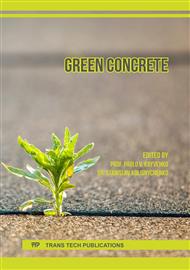p.200
p.207
p.216
p.222
p.228
p.233
p.239
p.246
p.253
Compressive Strength of Sustainable Concrete Mixes with Different Maximum Size Aggregates
Abstract:
The current study investigates the effect of aggregate’s maximum size on the compressive strength of sustainable flowable concrete. The concrete mixtures were mixed for 2 hours under lab controlled environment. The purpose of the prolonged mixing was to simulate concrete in a transit truck during transportation to a construction site. The mechanical properties of the mixes were investigated through compressive strength test. Three groups of concrete mixes were prepared: the first one with 20 mm maximum size aggregates, the second group with 10 mm maximum size aggregates and third group with 5 mm max size. The concrete mixes incorporated GGBs and fly ash (FA) in binary blends. To maintain consistent initial slump for all mixes, polycarboxylate based high-range water-reducing admixture (HRWR) was used. The concrete compressive strength was measured at 1, 3, 7, and 28 days. The results showed that the mechanical properties of sustainable flow mixtures investigated were highly affected by FA, GGBS, and maximum size aggregates.
Info:
Periodical:
Pages:
228-232
Citation:
Online since:
May 2019
Authors:
Price:
Сopyright:
© 2019 Trans Tech Publications Ltd. All Rights Reserved
Share:
Citation:



